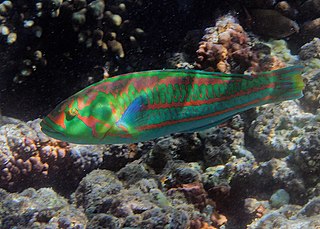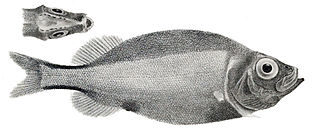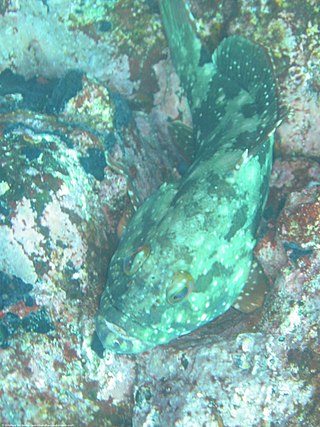
The bramble shark is one of the two species of sharks in the family Echinorhinidae. Aside from the eastern Pacific Ocean, it is found in tropical and temperate waters worldwide. This rarely encountered shark swims close to the bottom of the seafloor, typically at depths of 400–900 m (1,300–3,000 ft), though it may enter much shallower water. The bramble shark has a stout body with two small dorsal fins positioned far back and no anal fin. It can be readily identified by the large, thorn-like dermal denticles scattered over its body, some of which may be fused together. It is purplish brown or black in color and grows up to 3.1 m (10 ft) long.

The black goby is a species of ray-finned fish found in the Eastern Atlantic and Mediterranean Sea and Black Sea. It inhabits estuaries, lagoons, and inshore water over seagrass and algae. It feeds on a variety of invertebrates and sometimes small fish. This species can also be found in the aquarium trade.

The eight-lined wrasse is a species of marine ray-finned fish, a wrasse from the family Labridae, which is native to the Indian and Pacific Oceans. It occurs on coral reefs at depths from 2 to 50 m, preferring to shelter in niches and caves. It can also be found in the aquarium trade.

The surge wrasse, also known as the green-blocked wrasse, purple wrasse or red and green wrasse, is a species of wrasse native to the southeast Atlantic Ocean through the Indian and Pacific Oceans, where it inhabits reefs and rocky coastlines in areas of heavy wave action at depths from the surface to 10 m (33 ft). This species is of minor importance to local commercial fisheries, is popular as a game fish, and can be found in the aquarium trade.

Electrona risso is a species of myctophiform ray-finned fish in the family Myctophidae, the lanternfishes. It is known commonly as the electric lantern fish, chubby flashlight fish, and Risso's lantern-fish. It is a widespread species of all the oceans.
Citharichthys gymnorhinus, the anglefin whiff, is a species of flatfish in the large-tooth flounder family Paralichthyidae. It is a demersal marine fish that inhabits the mid to outer continental shelf of the western Atlantic Ocean, in both tropical and subtropical waters. It ranges from the Bahamas and Florida in the north to Guyana and Nicaragua in the south, though larvae samples have also been collected off the coast of Canada. It occurs at depths between 35 and 200 metres, but is most commonly found in shallower waters.

Paraclinus grandicomis, the horned blenny, is a perciform marine species of labrisomid blenny native to reefs of the Atlantic Ocean and the Caribbean Sea. It is a benthic fish so it cruises along above the sandy or rocky seabed and foraging for crustaceans.

Platytroctes apus is a species of ray-finned fish in the family Platytroctidae, the tubeshoulders. It is known commonly as the legless searsid and legless tubeshoulder. It is native to tropical and temperate oceans around the world. It has been found at depths between 385 and 5393 meters, but it generally remains between 1000 and 2000 meters.

Cantherhines pardalis is a species of fish in the family Monacanthidae, the filefishes. Common names include honeycomb filefish, honeycomb leatherjacket, and wire-netting filefish. It is native to the Indian Ocean, the eastern Atlantic, and the western Pacific, except for the seas around Hawaii, where it is replaced by Cantherhines sandwichiensis.

Epinephelus labriformis, commonly called starry grouper or flag cabrilla is a species of marine ray-finned fish, a grouper from the subfamily Epinephelinae which is part of the family Serranidae, which also includes the anthias and sea basses. It is found in the eastern Pacific Ocean.

Canthidermis maculata, also known as rough triggerfish or spotted oceanic triggerfish, is a species of triggerfish native to the tropical and subtropical oceans worldwide. Unlike most triggerfish, they are mostly pelagic.

Girella nigricans, commonly known as the opaleye or rudderfish, is a species of sea chub found in the Eastern Pacific, from California to southern Baja California. A rarely documented isolated population also exists in the Gulf of California, which might be genetically different from the rest of the species. They are commonly found in shallow waters and intertidal zones, usually over rocks and kelp beds, at depths of 1 to 32 m. They feed primarily on algae, but will occasionally consume sessile invertebrates. They are considered commercially important game fish.
Merluccius senegalensis, the Senegalese hake, is a species of fish from the family Merlucciidae, the true hakes. It is found in the sub tropical waters of the eastern Atlantic Ocean off the north western coast of Africa.

Brotula barbata, commonly known as the goatsbeard brotula, is a species of cusk-eel in the genus Brotula. It lives in the Indo-Pacific, in depths of up to 300 meters. It is dark brown with a submarginal black band and narrow white border on the dorsal and anal fins versus greenish to orange brown with orange-bordered dorsal and anal fins, and it grows up to be around 100 centimeters. It has a carnivorous diet, and it is oviparous.
Sparodon, commonly known as the white musselcracker, musselcracker seabream, mussel cracker seabream, brusher, or cracker. is a monotypic genus of fish in the family Sparidae. The type and only known species, Sparodon durbanensis, was first described and named by François Louis Nompar de Caumont de Laporte, comte de Castelnau, in 1861.
Barbantus curvifrons, commonly known as the palebelly searsid, is a species of ray-finned fish known from the Indian Ocean, the Pacific Ocean and the eastern Atlantic Ocean where it has been found at depths below 500 metres (1,600 ft). The generic name Barbantus is derived from the Latin, "barba", a beard.
Gerres nigri, the Guinean striped mojarra is a species of mojarra native to the eastern Atlantic Ocean. It inhabits estuaries, coastal waters and lagoons. This species can reach a maximum length of 20 cm (8 in), with 15 cm (6 in) being a more common size.

Epinephelus stoliczkae, the epaulet grouper, is a tropical fish species in the family Serranidae and in the genus Epinephelus.

Selene orstedii, the Mexican moonfish, is a species of ray-finned fish within the family Carangidae. The species is found in the eastern Pacific Ocean, off the coasts of Baja California, Mexico to Ecuador. It grows to a max length of 33 centimeters, but is more commonly found at 25 centimeters in length. Adults are found in shallow coastal waters at depths up to 50 meters below sea level, usually near the seafloor. Its diet consist of squid, small crabs, small fishes and polychaetes.
Zu elongatus, the taper-tail ribbonfish, is a species of ray-finned fish within the family Trachipteridae. The species distribution is likely in temperate and tropical waters in all oceans, but has only been occurred in the Atlantic and Pacific off Namibia, the western Cape coast, and New Zealand. It inhabits mesopelagic waters up to 1200 meters below sea level. Other common names include the scalloped dealfish and spitsstert-lintvis in Afrikaans.
















